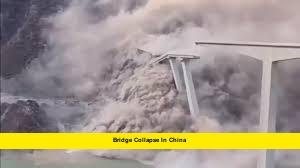A bridge collapse in China has drawn international attention after a major section of the Hongqi Bridge in Sichuan province suddenly gave way on Tuesday, November 11, 2025. The incident occurred just months after the bridge’s grand opening, raising widespread concern over infrastructure safety and construction standards in the region.
What Happened in the Bridge Collapse in China
The Hongqi Bridge, located in Maerkang city in southwestern China’s Sichuan province, partially collapsed following days of heavy rainfall and mountain instability. Early assessments suggest that the surrounding slopes and terrain had begun shifting, causing cracks to appear along the bridge approach before the structure gave way.
Authorities confirmed that the bridge had been closed to traffic a day prior after engineers detected warning signs of geological movement. Despite precautionary measures, the hillside near one end of the bridge reportedly gave way, causing a large section to collapse into the valley below.
Thankfully, as of this writing, no casualties or injuries have been reported. Local officials stated that early closure of the bridge likely prevented loss of life, as maintenance crews had already evacuated the area when the collapse occurred.
Details of the Bridge and Its Construction
- Name: Hongqi Bridge
- Location: Maerkang City, Aba Prefecture, Sichuan Province
- Length: Approximately 758 meters (2,487 feet)
- Opened: Early 2025
- Collapsed: November 11, 2025
- Casualties: None reported
- Cause (Preliminary): Landslide and soil instability in surrounding mountain terrain
The Hongqi Bridge was a critical link on a regional highway connecting central China to the Tibetan Plateau. Its design was praised for improving connectivity in one of China’s most rugged areas. However, the region’s natural instability and frequent rainfall make it particularly prone to landslides.
Immediate Response and Investigation
Emergency response teams and geological experts were dispatched shortly after the bridge collapse. The area surrounding the damaged structure remains closed off as crews assess terrain safety and investigate the full extent of the damage.
Authorities have launched a formal investigation into the cause of the collapse, focusing on three main areas:
- Geological Conditions: Ongoing instability in the mountainous terrain surrounding the bridge.
- Engineering and Design: Possible design weaknesses in accommodating terrain movement and drainage.
- Construction Quality: Whether the materials and construction methods met required safety standards.
Officials have also stated that other bridges in the region are undergoing immediate inspection to ensure public safety.
Impact on Transportation and Local Communities
The collapse has disrupted a major transport artery used for regional trade and travel between Sichuan and western China. Detours have been set up through nearby provincial roads, but travel times have increased significantly due to the mountainous terrain.
For residents of Maerkang city and nearby villages, the Hongqi Bridge was a vital connection for goods, services, and emergency access. Its temporary closure is expected to affect daily transportation and local economies until a replacement or repair plan is in place.
Why the Bridge Collapse in China Matters
This incident has renewed public scrutiny over infrastructure development and quality control in China. Over the past decade, the country has rapidly expanded its road and bridge network, especially in remote areas. While these projects have improved access and economic growth, some have raised concerns about the long-term durability and environmental challenges of such large-scale construction in mountainous zones.
For global observers, the Hongqi Bridge collapse serves as a reminder that even newly built structures can be vulnerable when facing natural forces like landslides, soil erosion, or seismic activity. It also highlights the importance of thorough environmental studies and maintenance monitoring—lessons relevant not only to China but to countries worldwide investing heavily in infrastructure.
Expert Analysis: Understanding the Causes
Geotechnical experts emphasize that the primary cause appears to be terrain instability rather than design failure. Mountainous areas in Sichuan are known for their soft sedimentary layers, which can shift suddenly after prolonged rainfall. When this happens, even stable structures may lose foundational support.
Some reports indicate that early warning sensors on the Hongqi Bridge detected soil movement hours before the collapse, prompting the closure. Such early-detection systems are critical, but they also rely on rapid decision-making and real-time coordination between engineers and local authorities.
Safety Measures and Future Plans
Chinese transportation authorities have pledged to:
- Conduct comprehensive inspections of similar bridge structures in the province.
- Implement advanced slope monitoring technology in high-risk areas.
- Review construction approval processes for projects in geologically sensitive zones.
- Establish long-term geological observation stations to detect underground movements early.
Reconstruction of the damaged bridge will only begin once the site is deemed geologically stable. Engineers are expected to redesign the new span with improved support systems, deeper foundations, and enhanced landslide protection.
Broader Context: China’s Infrastructure Ambitions
China has built thousands of bridges in recent decades, many of them in regions with extreme topography. While the country’s engineering achievements—such as the world’s longest and highest bridges—are globally recognized, incidents like the Hongqi Bridge collapse remind the public that maintenance, inspection, and environmental monitoring are equally vital.
For U.S. readers, the situation also draws parallels to infrastructure debates at home, where aging bridges and roads require continual funding and modernization. Both nations face the challenge of ensuring safety while pursuing ambitious infrastructure expansion.
Public Reaction
Social media platforms in China have been filled with discussions about the collapse. Many users expressed relief that no lives were lost, while others called for greater transparency in the investigation. There is growing public demand for stricter oversight of construction practices and more rigorous inspections, especially for projects in high-risk areas.
Officials have urged patience while engineers and investigators determine the exact cause. Reconstruction timelines are expected to be announced after safety assessments are complete.
As rescue teams continue their work and engineers analyze the causes, the bridge collapse in China stands as a reminder of the ongoing balance between development and safety in rapidly changing landscapes. Stay tuned for verified updates and share your thoughts below on how such incidents should shape future infrastructure planning.
